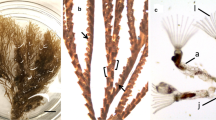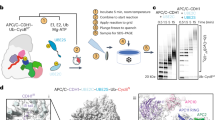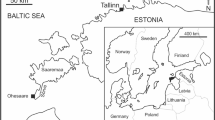Abstract
‘Candidatus Endobugula sertula,’ the uncultivated γ-proteobacterial symbiont of the marine bryozoan Bugula neritina, synthesizes bryostatins, complex polyketides that render B. neritina larvae unpalatable to predators. Although the symbiosis is well described, little is known about the locations of ‘E. sertula’ or the bryostatins throughout larval settlement, metamorphosis and early development. In this study, we simultaneously localized ‘E. sertula’ and the bryostatins in multiple stages of the B. neritina life cycle, using a novel bryostatin detection method based on its known ability to bind mammalian protein kinase C. Our results suggest that the bryostatins are deposited onto the exterior of B. neritina larvae during embryonic development, persist on the larval surface throughout metamorphosis and are shed prior to cuticle formation. During metamorphosis, ‘E. sertula’ remains adhered to the larval pallial epithelium and is incorporated into the preancestrula cystid tissue layer, which ultimately develops into a bud and gives rise to the next zooid in the colony. Colocalization of bryostatin signal with aggregates of ‘E. sertula’ in buds of ancestrulae suggested new synthesis of bryostatins in ancestrulae. In adult B. neritina colonies, symbiont microcolonies were observed in the funicular cords of rhizoids, which likely result in asexual transmission of ‘E. sertula’ to regenerated colonies. Furthermore, bryostatin signal was detected on the surface of the rhizoids of adult B. neritina colonies. Through simultaneous localization of the bryostatins and the ‘E. sertula,’ we determined how ‘E. sertula’ is transmitted, and identified shifts in bryostatin localization throughout the life cycle of the host B. neritina.
Similar content being viewed by others
Log in or create a free account to read this content
Gain free access to this article, as well as selected content from this journal and more on nature.com
or
References
Amann RI, Binder BJ, Olson RJ, Chisholm SW, Devereux R, Stahl DA . (1990). Combination of 16S rRNA-targeted oligonucleotide probes with flow cytometry for analyzing mixed microbial populations. Environ Microbiol 56: 1919–1925.
Daniels R, Vanderleyden J, Michiels J . (2004). Quorum sensing and swarming migration in bacteria. FEMS Microbiol Rev 28: 261–289.
Davidson SK . (1999). Biology of the bryostatins in the marine bryozoan Bugula neritina: symbiosis, cryptic speciation and chemical defense. PhD dissertation, University of California San Diego, La Jolla.
Davidson SK, Allen SW, Lim GE, Anderson CM, Haygood MG . (2001). Evidence for the biosynthesis of bryostatins by the bacterial symbiont ‘Candidatus Endobugula sertula’ of the bryozoan Bugula neritina. Appl Environ Microbiol 67: 4531–4537.
DeVries DJ, Herald CL, Pettit GR, Blumberg PM . (1988). Demonstration of sub-nanomolar affinity of bryostatin 1 for the phorbol ester receptor in rat brain. Biochem Pharmacol 37: 4068–4073.
Gillor O, Carmeli S, Rahamim Y, Fishelson Z, Ilan M . (2000). Immunolocalization of the toxin latrunculin B within the Red Sea sponge Negombata magnifica. Mar Biotechnol 2: 213–223.
Gordon DP . (1977). The aging process in bryozoans. In: Woollacott RM, Zimmer RL (eds). Biology of Bryozoans. Academic Press: New York, pp 335–375.
Haygood MG, Davidson SK . (1997). Small-subunit rRNA genes and in situ hybridization with oligonucleotides specific for the bacterial symbionts in the larvae of the bryozoan Bugula neritina and proposal of ‘Candidatus Endobugula sertula’. Appl Environ Microbiol 63: 4612–4616.
He XS, Fuqua C . (2006). Rhizosphere communication: quorum sensing by the rhizobia. J Microbiol Biotechnol 16: 1661–1677.
Hildebrand M, Waggoner L, Liu H, Sudek S, Allen S, Anderson C et al. (2004). BryA: an unusual modular polyketide synthase gene from the uncultivated bacterial symbiont of the marine bryozoan Bugula neritina. Chem Biol 11: 1543–1552.
Kraft AS, Smith JB, Berkow RL . (1986). Bryostatin, an activator of the calcium phospholipid-dependent protein kinase, blocks phorbol ester-induced differentiation of human promyelocytic leukemia cells HL-60. Proc Natl Acad Sci USA 83: 1334–1338.
Kuzirian AM, Epstein HT, Gagliardi CJ, Nelson TJ, Sakakibara M, Taylor C et al. (2006). Bryostatin enhancement of memory in Hermissenda. Biol Bull 210: 201–214.
Lim GE, Haygood MG . (2004). ‘Candidatus Endobugula glebosa’, a specific symbiont of the marine bryozoan Bugula simplex. Appl Environ Microbiol 70: 4921–4929.
Lindquist N, Hay ME . (1996). Palatability and chemical defense of marine invertebrate larvae. Ecol Monogr 66: 431–450.
Lopanik NB, Lindquist N, Targett N . (2004). Potent cytotoxins produced by a microbial symbiont protect host larvae from predation. Oecologia 139: 131–139.
Lopanik NB, Targett NM, Lindquist N . (2006). Ontogeny of a symbiont-produced chemical defense in Bugula neritina (Bryozoa). Mar Ecol Prog Ser 327: 183–191.
Lupp C, Ruby EG . (2005). Vibrio fischeri uses two quorum-sensing systems for the regulation of early and late colonization factors. J Bacteriol 187: 3620–3629.
Miller MB, Bassler BL . (2001). Quorum sensing in bacteria. Annu Rev Microbiol 55: 165–199.
Parkinson DR, Arbuck SG, Moore T, Pluda JM, Christian MC . (1994). Clinical development of anticancer agents from natural products. Stem Cells 12: 30–43.
Pettit GR, Herald CL, Doubek DL, Herald DL . (1982). Isolation and structure of bryostatin 1. J Am Chem Soc 104: 6846–6847.
Salomon CE, Deerink T, Ellisman MH, Faulkner DJ . (2001). The cellular localization of dercitamide in the Palauan sponge Oceanapia sagittaria. Mar Biol 139: 313–319.
Schroder HC, Breter HJ, Fattorusso E, Ushijima H, Wiens M, Steffen R et al. (2006). Okadaic acid, an apoptogenic toxin for symbiotic/parasitic annelids in the demosponge Suberites domuncula. Appl Environ Microbiol 72: 4907–4916.
Sudek S, Lopanik NB, Waggoner LE, Hildebrand M, Anderson C, Liu HB et al. (2007). Identification of the putative bryostatin polyketide synthase gene cluster from ‘Candidatus Endobugula sertula,’ the uncultivated microbial symbiont of the marine bryozoan Bugula neritina. J Nat Prod 70: 67–74.
Sun MK, Alkon DL . (2005). Dual effects of bryostatin-1 on spatial memory and depression. Eur J Pharmacol 525: 171.
Sun MK, Alkon DL . (2006). Bryostatin 1: pharmacology and therapeutic potential as a CNS drug. CNS Drug Rev 12: 1–8.
Wender PA, Cribbs CM, Koehler KF, Sharkey NA, Herald CL, Kamano Y et al. (1988). Modeling of the bryostatins to the phorbol ester pharmacophore on protein kinase-C. Proc Natl Acad Sci USA 85: 7197–7201.
Woollacott RM . (1981). Association of bacteria with bryozoan larvae. Mar Biol 65: 155–158.
Woollacott RM, Zimmer RL . (1977). Metamorphosis, ancestrulae, and coloniality in bryozoan life cycles. In: Woollacott RM, Zimmer RL (eds). Biology of Bryozoans. Academic Press: New York, pp 91–142.
Woollacott RM, Zimmer RL . (1978). Metamorphosis of cellularioid bryozoans. In: Chia FS, Rice ME (eds). Settlement and Metamorphosis of Marine Invertebrate Larvae. Elsevier/North-Holland Biomedical Press: New York, pp 49–63.
Yool AJ, Grau SM, Hadfield MG, Jensen RA, Markell DA, Morse DE . (1986). Excess potassium induces larval metamorphosis in four marine invertebrate species. Biol Bull 170: 255–266.
Acknowledgements
We thank C Sheehan, R McConaughey, D Edwards, E Kisfaludy, C Anderson and S Sudek for assistance with B. neritina collection. G Lim provided B. simplex and B. turrita larvae, A Newton helped with initial design of the bryostatin detection method and H Trapido-Rosenthal advised on protocols for settlement induction. We also thank Sandra Oster, two anonymous reviewers and an editor for comments that improved this manuscript. This work was funded by California Sea Grant (R/MP-88), the National Institutes of Health (grant 5R01CA079678-03) and the Scripps Institution of Oceanography Graduate Student Office. KHS was supported by the Los Angeles ARCS Foundation. SKD was supported by NSF Grant IOB 0345049.
Author information
Authors and Affiliations
Corresponding author
Rights and permissions
About this article
Cite this article
Sharp, K., Davidson, S. & Haygood, M. Localization of ‘Candidatus Endobugula sertula’ and the bryostatins throughout the life cycle of the bryozoan Bugula neritina. ISME J 1, 693–702 (2007). https://doi.org/10.1038/ismej.2007.78
Received:
Revised:
Accepted:
Published:
Issue date:
DOI: https://doi.org/10.1038/ismej.2007.78
Keywords
This article is cited by
-
Seasonal dynamics of a complex cheilostome bryozoan symbiosis: vertical transfer challenged
Scientific Reports (2023)
-
Unprecedented frequency of mitochondrial introns in colonial bilaterians
Scientific Reports (2022)
-
First evidence of virus-like particles in the bacterial symbionts of Bryozoa
Scientific Reports (2021)
-
Draft genome of Bugula neritina, a colonial animal packing powerful symbionts and potential medicines
Scientific Data (2020)
-
Diversity and Dynamics of “Candidatus Endobugula” and Other Symbiotic Bacteria in Chinese Populations of the Bryozoan, Bugula neritina
Microbial Ecology (2019)



